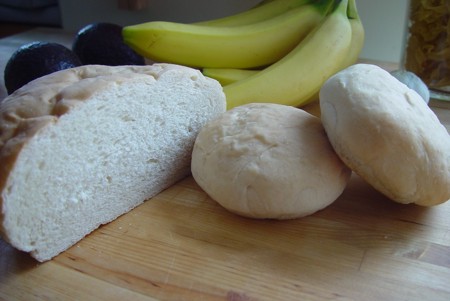!f there’s one thing everyone who’s interested in cooking should know, its the basics that go into making a good loaf of bread. It’s not complicated and it’s not hard – especially if you have a stand mixer with a dough hook!
 A free-form (round) loaf and two rolls made by Maggie J’s Simple One-Rise Method.
A free-form (round) loaf and two rolls made by Maggie J’s Simple One-Rise Method.
You can make it all: Plain White Loaf or rolls, Rye Bread, Sourdough, Italian Focaccia and Chiabata, Mediterranean Pita, and a whole host of other Flat Breads from around the world. They all have some characteristics in common, and many of the basic skills and techniques transcend cultures and even civilizations.
Bread is old and venerable. Bread and wine, which both rely on the fermentation process, are among the oldest foods made my humankind, continuously, since ancient times. To ‘break bread’ with others is not only a legendary cultural activity but a spiritual one, especially for Christians who believe that Jesus Christ gave his disciples the communion ceremony, using bread and wine, at the last supper. When all else is unavailable, bread remains the ultimate staple. Basically, you really oughta know how to make it!
The simplest way…
The simplest bread recipe I know is the following one, which takes a couple of steps out of the classic, two-rise procedure and changes the proportions of some ingredients a little. But it works like a charm and the resulting loaves or rolls will stay fresh for days if properly stores.
For two small (700 g) loaves or six large round rolls you’ll need:
3 cups Bread Flour
1.5 tsp Salt
4 tsp. Active Dry Yeast
1 cup Hot Water, with two tsp White Sugar dissolved in it
2 more tsp. White Sugar
2 tbsp. of vegetable shortening or vegetable oil
1 Egg, well beaten, to brush the tops of the loaves or rolls
Preheat your oven to 350 F, on ‘Bake’.
Combine all the dry ingredients (Flour, Sugar, Salt) in a large mixing bowl and stir briskly with a whisk. This does the same job as sifting the flour and mixes the ingredients thoroughly.
Combine the Yeast and sugared hot water in a separate heat-proof vessel (I use a Pyrex measuring cup), stirring well, until the yeast in dissolved. Place it on the top of the pre-heating stove to get started.
When the yeast mixture is foaming nicely, pour it into the middle of the flour mixture and, while stirring gently with the handle end of a big wooden spoon, add the oil. once you’ve got everybody in the pool, go in with your bare hands (or wear gloves if you wish) and knead the dough by folding it over itself again and again and pressing down with the heel of your palm. If you have a stand mixer with a dough hook attachment, use that and disregard any specific reference to hand kneading that follow.
If the dough is too dry, add more hot water as needed, a couple of tablespoons at a time, and continue kneading (for several minutes) until the dough ball absorbs most of the flour and the surface is soft, velvety and not too sticky. For this recipe, you do want the dough a little on the wet side, though, so don’t worry if it sticks to your hands a bit.
place the dough ball in a clean bowl at least as large as the one you mixed it in and give it a thin coat of vegetable oil all over, so it doesn’t dry out or crust over while rising. Place a well-moistened kitchen town over top of the bowl as added insurance against drying. Place the covered bowl on, the nice warm, stove top to rise.
When the dough has at least doubled in volume, turn it out onto a well-floured work surface and flatten it with your fingertips to about an inch thick. then, roll it up into a roll and tuck in the ends. Divide the roll in half for two loaves, or in 6 for rolls. Form the loaves or rolls by first rounding off each dough ball by rolling it on the work surface, then turning the edges of each dough ball under to form a seamless loaf or roll.
Place rolls on a cookie sheet lined with parchment paper leaving lots of room between them for expansion, or place loaves in well-greased loaf pans. Cover the loaves or rolls with the dampened towel again and let them rise for at least 45 minutes, or until they’ve doubled in volume again.
Brush with your beaten egg for a golden, glazed top crust.
Bake rolls in the 350 F oven for 25 min. or so, until they are golden brown on the top, and the crust is firm.
Bake loaves for 30 to 40 minutes, until they are golden brown on top and no longer make a hollow sound when you tap them on their top crust.
Remove rolls or loaves from the oven and cool on a rack. Store tightly wrapped in plastic at room temperature, or freeze tightly wrapped in plastic. To thaw, leave wrapped on the counter overnight or microwave for two minutes (per loaf) on high.
You can do it!
Give it a try… You’ll be amazed at what you can do with a few ingredients and your own two hands!
~ Maggie J.
